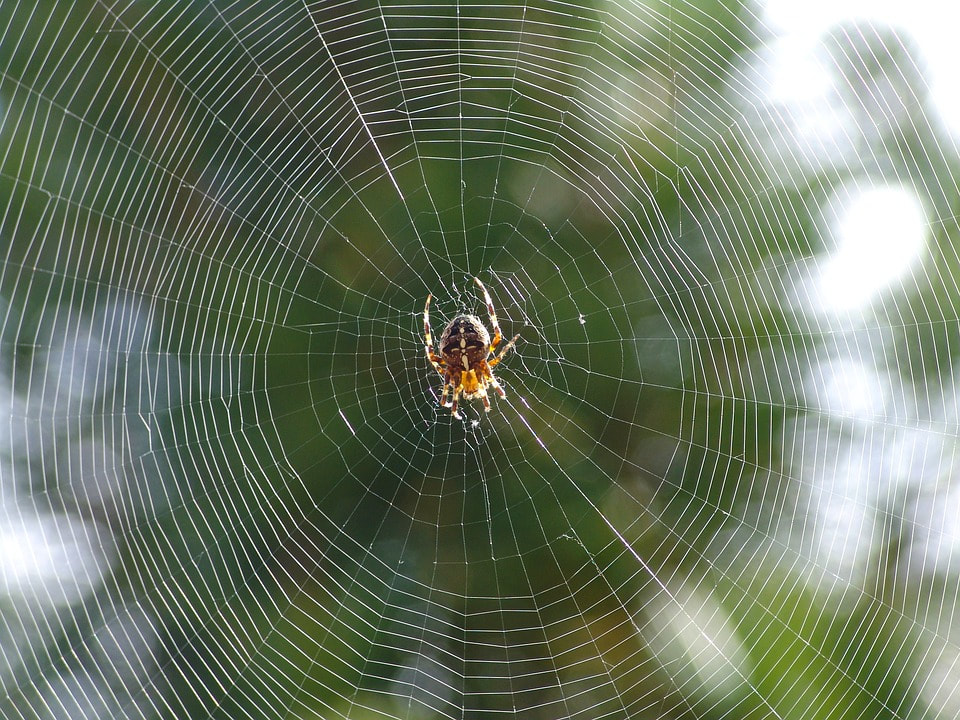|
Look across open parkland on a September morning and you will see thousands of tiny golden stands undulating across the dewy grass. In sheltered valleys, lingering mists hang glittering pearls on newly-formed webs. Sitting noticeably lower in the sky, the September sun casts golden shafts of light across the land. Some of these rays get caught in the circular cobwebs that decorate our hedgerows and gardens at this time of year. At the centre of each web sits a plump orb spider – monstrous yet beautiful – provoking both fear and wonder.
The marvellous webs we see at this time of year are made by the Garden Cross spider. Their intricacy gives the appearance of being a product of cognitive powers rather than instinctual geometry. Amazingly, the spider eats its web completely at sunset, recycling the proteins contained in the silk re-absorbing them into its body. Over night a new web is woven, before the rise of the sun heralds a new day of static hunting. The spider’s several spinnerets produce different kinds of silk – some strong for the lines forming the outside framework and anchors of the web; some the robust radial axis into the centre; some forming the centre on which the spider sits. All of these are not sticky. Only the main circular web holds the droplets of glue which capture the spider’s prey. To avoid being caught in its own trap, the spider’s feet secrete an oily substance resistant to its own glue. There is one strong main line which travels through from one side of the web to the other. This is the signal wire on which the spider rests its front pair of feet - sensing the vibrations of trapped insects. This line of communication allows the spider to launch its attach on the ensnared insect. Sometimes we get can get caught in a sticky web of our own making (often in response to our environment) and we can end up feeling very stuck. Our psyche is constructed of infinite psychic connections and sometimes we seem unable to make sense of the myriad strands. For many, a therapist is sought when one feels the need to take on a new identity – sensing a need to shed old, out-dated, constricting skin. Sometimes we spin a shroud for our feelings and memories of which we are ashamed and hide them away in some dark and deathly-quiet tomb. We dare not speak of these things lest we incur the humiliating judgement of others. It is only when we feel safe enough to speak our shame to someone that we truly trust can we then accept ourselves with compassion. You would think that spiders with their eight eyes, sitting at the centre of their web, would have a panoramic view. However, they actually have quite poor eye sight. They sense the world around them through vibration: sometimes we feel things instinctively rather than clearly seeing what’s around us or within us. Often, freedom is born from a change of perception, requiring that we re-frame things in order to look at them differently. At the centre of our psychic web sits our core beliefs. They do not possess any subtly of shade – only light or dark, operating in terms of polar extremes: we are good or bad; ugly or beautiful; rich or poor. However, it is only when we find a way to get our head and heart to sing together can we then begin to shift our core beliefs. Through this process, we can begin to see ourselves in a new light and perhaps start to perceive the world differently. We can learn how to accept our monstrosities and celebrate our beauty. The Art of Making a Web You are invited to take a ball of twine out into a natural place of your choosing. Look around and find a tree that you are drawn too – preferably one with accessible branches. Weave yourself a web in the branches. When you are satisfied with your creation, think about aspects of yourself that sit in opposition. Find natural objects that reflect these aspects of yourself and tie them into the web. How do these parts of you manifest themselves? What is useful to you, what is less helpful? Can you accept some aspects in the here-and-now or do others need to change? What would you like to be different and how would you go about making the necessary changes?
0 Comments
Leave a Reply. |
AuthorSimon Wodward, Indoor and Outdoor Art Therapist Archives
April 2017
Categories |


 RSS Feed
RSS Feed
